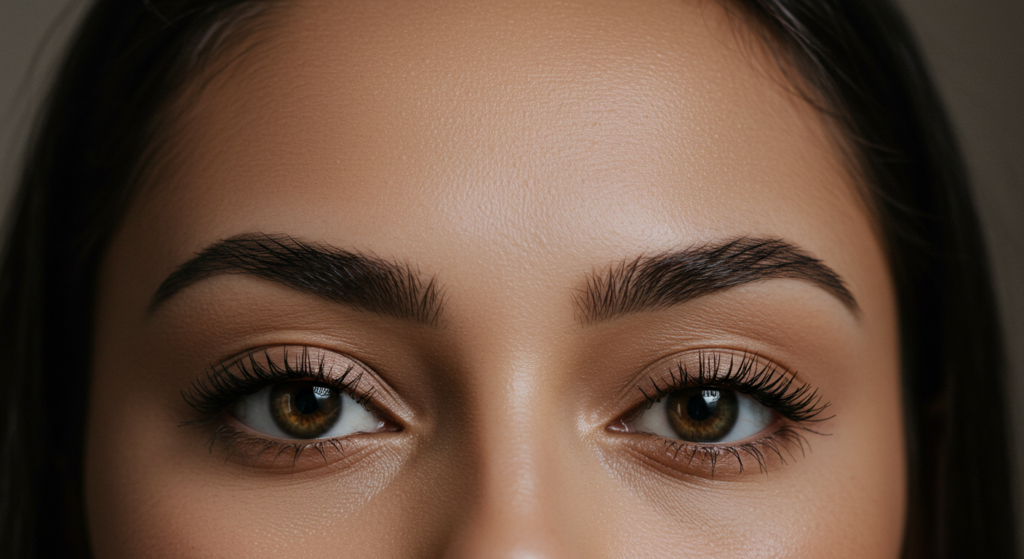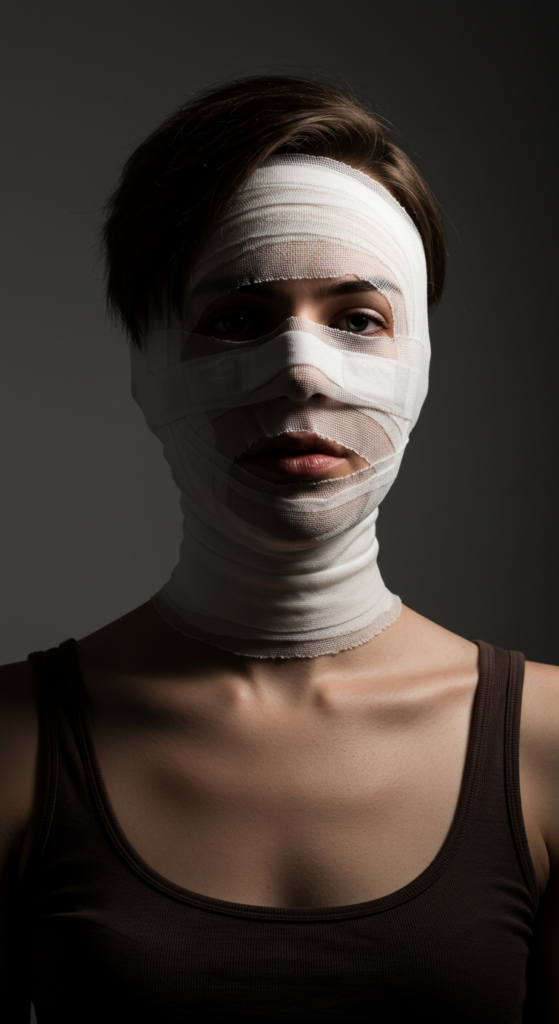In the realm of Facial Feminization Surgery (FFS), forehead contouring stands as one of the most impactful procedures for achieving a significant degree of facial feminization. The forehead and brow ridge are key sexually dimorphic areas, exhibiting distinct differences between typically masculine and feminine faces. Forehead contouring in FFS aims to reshape the bony and soft tissue structures of the forehead to create a smoother, flatter, and more feminine brow and upper face.
For individuals seeking a profound facial feminization transformation, addressing the forehead is often considered essential. Let’s delve into the techniques used in forehead contouring in FFS, the results they can achieve, and what patients can expect from this transformative procedure.
Table of Contents
Why Forehead Contouring is Crucial for Facial Feminization (Forehead Contouring in FFS)
The masculine forehead differs significantly from the typically feminine forehead. Understanding these differences highlights why forehead contouring is so important.
Key Differences: Masculine vs. Feminine Foreheads
- Brow Ridge Bossing (Supraorbital Ridge): Masculine foreheads typically exhibit a prominent brow ridge, also known as brow bossing or supraorbital ridge. This is a bony protrusion just above the eyes, creating a heavier, more shadowed appearance to the upper face. Feminine foreheads are generally much flatter and smoother in this area, with minimal or no brow bossing.
- Forehead Slope/Recession: Masculine foreheads often have a more backward sloping or receding hairline and forehead profile. Feminine foreheads tend to be more vertical or slightly convex in profile, contributing to a fuller, rounder appearance.
- Forehead Height (Relative): While not always a dramatic difference, masculine foreheads can sometimes appear slightly shorter and wider in proportion to the rest of the face compared to typically feminine foreheads.
- Glabella (Area between eyebrows): The glabella, the area between the eyebrows above the nose bridge, is often more prominent and projecting in masculine foreheads and smoother and flatter in feminine foreheads.
Feminizing Effects of Forehead Contouring:
- Removal or Reduction of Brow Bossing: Creates a smoother, flatter, and less shadowed upper face, instantly feminizing the brow and eye area.
- Forehead Reshaping and Contouring: Reshapes the overall forehead contour to a more vertical, less sloped, and more gently curved feminine form.
- Softening of the Upper Face: Reduces the heavy, angular appearance of the masculine brow and forehead, creating a softer, more open, and approachable feminine upper face.
- Enhanced Feminine Eye Presentation: By removing brow bossing, forehead contouring “opens up” the eyes, making them appear larger, brighter, and more typically feminine.
- Improved Facial Harmony: Creates balance and harmony with other feminized facial features, contributing significantly to overall facial feminization and gender congruence.

Techniques in Forehead Contouring for FFS (Forehead Contouring in FFS)
Forehead contouring in FFS is not a single procedure, but a set of surgical techniques tailored to address the specific bony and soft tissue characteristics of each individual’s forehead. The primary techniques include:
1. Brow Bone Reduction (Type 3 Foreheadplasty): Erasing Brow Bossing
Technique: Type 3 foreheadplasty, specifically brow bone reduction, is considered the most effective and impactful technique for eliminating or significantly reducing brow bossing. It involves:
- Scalp Incision (Coronal Incision): Typically made along the hairline, often hidden within the scalp to minimize visible scarring. In some cases, an endoscopic approach with smaller incisions may be possible, though less common for significant bossing.
- Forehead Bone Exposure: Careful dissection to expose the frontal bone of the forehead and the brow bone (supraorbital rim).
- Brow Bossing Osteotomy: Using specialized surgical saws and instruments, the prominent outer table of the brow bone (the front layer of the bone) is carefully separated from the inner table.
- Bone Recontouring and Setback: The outer table of the brow bone is then reshaped, thinned, and set back – essentially “erasing” the brow ridge prominence. The inner table remains intact for structural support and protection of the frontal sinus (air-filled space behind the brow bones).
- Fixation (Sometimes): In some techniques, the reshaped outer table may be fixed in its new position with small titanium screws or resorbable materials to ensure stable healing.
- Scalp Closure: The scalp incision is meticulously closed in layers.
Feminizing Effects:
- Complete or Near-Complete Brow Bossing Removal: Effectively eliminates or dramatically reduces the masculine brow ridge, creating a flat or subtly curved feminine brow.
- Smoother Forehead Profile: Creates a much smoother and more vertical forehead profile.
- Dramatic Feminization Impact: Often considered the single most impactful procedure in FFS for achieving profound facial feminization.
Advantages:
- Most Effective for Brow Bossing: Gold standard for significant brow bossing reduction.
- Long-Lasting, Permanent Results: Bone reshaping provides permanent feminization.
- Significant Feminine Transformation: Creates a dramatic and noticeable feminizing effect.
Considerations:
- More Complex Surgery: Involves bone osteotomies and is a more complex surgical procedure requiring specialized skill.
- Slightly Longer Recovery: Recovery may be slightly longer compared to less invasive procedures.
- Scalp Incision and Potential Scar: Typically requires a coronal (hairline) incision, although surgeons aim to minimize scar visibility by placing it along the hairline.

2. Forehead Bone Contouring/Shaving (Type 1 Foreheadplasty): For Minor Bossing or Refinement
Technique: Type 1 foreheadplasty, or forehead bone contouring/shaving, is a less invasive technique suitable for individuals with mild brow bossing or those seeking subtle forehead refinement. It involves:
- Limited Incisions (Hairline or Endoscopic): Smaller incisions, potentially at the hairline or using an endoscopic approach with very small incisions within the scalp.
- Bone Exposure (Limited): Limited exposure of the forehead bone in the area requiring contouring.
- Bone Shaving/Burring: Specialized surgical burrs and instruments are used to shave down and contour the outer surface of the brow bone and forehead bone. This technique removes bone but does not involve separating and repositioning bone segments like in Type 3.
- Incision Closure: Incisions are closed.
Feminizing Effects:
- Subtle Brow Bossing Reduction: Can reduce minor degrees of brow bossing by shaving down the bone prominence.
- Forehead Smoothing and Contouring: Smooths out minor irregularities or bumps on the forehead bone surface.
- Refinement, Not Dramatic Change: Provides more subtle feminization compared to Type 3, suitable for minor corrections or those with naturally less prominent bossing.
Advantages:
- Less Invasive: Less extensive surgery compared to Type 3 foreheadplasty.
- Quicker Recovery (Potentially): Recovery may be somewhat faster than Type 3.
- Smaller Incisions, Less Scarring: Smaller incisions and potentially less visible scarring.
Considerations:
- Limited Bossing Reduction: Not effective for moderate to severe brow bossing. Type 3 is required for significant bossing.
- Subtle Results: Results are more subtle compared to Type 3.
- May Not Be Sufficient Feminization for All: For individuals with significant brow bossing, Type 1 alone is unlikely to achieve sufficient feminization.
3. Hairline Lowering (Scalp Advancement): Vertical Forehead Reduction and Feminization
Technique: Hairline lowering, also known as scalp advancement, is a technique used to lower a high or receding hairline, which is often perceived as a masculine trait, and to shorten a vertically tall forehead.
- Hairline Incision: An incision is made along the desired new, lower hairline.
- Scalp Undermining and Advancement: The scalp is carefully undermined and advanced forward and downward to the level of the new hairline incision. This effectively moves the hairline forward and reduces forehead height.
- Excess Forehead Skin Removal: The excess forehead skin above the advanced hairline is removed.
- Scalp Closure: The scalp is meticulously closed, bringing the hairline to its new, lower position.
Feminizing Effects:
- Lowered Hairline: Creates a more feminine, lower hairline position, framing the face more attractively.
- Reduced Forehead Height: Shortens a vertically tall forehead, creating more feminine facial proportions.
- Rounder Forehead Shape (Indirectly): By lowering the hairline and reducing forehead height, it can contribute to a more rounded and less sloping overall forehead appearance.
- Softer Framing of the Face: A lower hairline softens the upper face and frames the face in a more feminine manner
- More Feminine Hairline Shape: Beyond just lowering, the hairline shape itself can be feminized during scalp advancement surgery. Surgeons often aim to create a softer, more rounded, and less angular hairline shape, further enhancing femininity.
Advantages of Hairline Lowering:
- Effective for High Hairlines: Directly addresses and corrects a high or receding hairline, a common concern for many seeking facial feminization.
- Significant Forehead Height Reduction: Can reduce forehead height by a noticeable amount, creating more feminine facial proportions.
- Relatively Straightforward Procedure (for experienced surgeons): While technically precise, scalp advancement is a well-established and relatively predictable procedure in the hands of experienced surgeons.
- Scar Concealed at Hairline (Typically): Incision line is placed along the new hairline, often becoming well-concealed as hair grows through it over time.
Considerations:
- Hairline Scar Visibility (Initial): In the immediate post-operative period, the hairline incision will be visible as a fine line and may be slightly red. This typically fades significantly over time, especially as hair grows through the incision. Proper scar care is crucial.
- Potential for Temporary Hair Shedding (Effluvium): Scalp surgery can sometimes cause temporary hair shedding (telogen effluvium) around the incision line. This is usually temporary, and hair growth typically recovers within a few months.
- Scalp Tightness (Temporary): Patients may experience some scalp tightness or tension in the weeks and months following surgery as the scalp adjusts to its new position. This usually resolves over time.
- Not for Brow Boss Elimination: Hairline lowering addresses hairline position and forehead height, but does not directly address brow bone bossing. Brow bone reduction (Type 3) or contouring (Type 1) are needed for brow bossing.

4. Combined Techniques: The Holistic Forehead Feminization Approach (Forehead Contouring in FFS)
Often, the most effective forehead feminization involves combining techniques tailored to the individual’s specific anatomy and feminization goals. A holistic approach might include:
- Type 3 Brow Bone Reduction and Hairline Lowering: For individuals with significant brow bossing and a high hairline, combining these two procedures in a single surgical session can achieve a comprehensive forehead feminization result. This is a very common and powerful combination.
- Type 1 Forehead Contouring and Hairline Lowering: For those with mild brow bossing or primarily seeking forehead shape refinement and hairline lowering, a combination of Type 1 contouring and hairline advancement can be effective.
- Glabella Contouring (Often part of Brow Bone Reduction): The glabella (area between eyebrows) is often addressed during brow bone reduction surgery, further smoothing and feminizing the upper face.
- Temporal Area Contouring (Sometimes): In some cases, contouring of the temporal areas (sides of the forehead near the temples) may be included to further refine the overall forehead shape and contribute to a more feminine upper facial contour.
The Surgeon’s Role in Technique Selection:
A skilled and experienced FFS surgeon will meticulously assess your individual forehead anatomy, including brow bossing prominence, forehead slope, hairline height, and overall facial proportions. Based on this assessment and your feminization goals, the surgeon will recommend the most appropriate combination of forehead contouring techniques to achieve the optimal feminine outcome for you.
Expected Outcomes of Forehead Contouring in FFS: A Smoother, Softer Brow
When expertly performed, forehead contouring in FFS can deliver remarkable and transformative feminine results.
Key Feminine Forehead Outcomes:
- Smooth, Flat Brow Profile: Elimination or significant reduction of brow bossing, creating a smooth and feminine brow contour.
- Softer, More Open Upper Face: The brow area appears less heavy, less shadowed, and more open and inviting.
- Feminine Forehead Shape: Reshaped forehead with a more vertical or gently curved profile, replacing a masculine sloped or receding appearance.
- Lower, Feminine Hairline: A lower hairline frames the face more femininely and reduces forehead height.
- Larger, Brighter-Appearing Eyes: By removing brow bossing, the eyes are “unveiled” and appear more prominent, open, and typically feminine.
- Harmonious Facial Feminization: Forehead contouring is a cornerstone of overall FFS, creating balance and harmony with other feminized features for a cohesive feminine facial aesthetic.
- Increased Confidence and Gender Affirmation: Patients often experience a significant increase in self-confidence and gender affirmation as their forehead and brow area aligns more closely with their gender identity.
Realistic Expectations:
- Dramatic Feminization Potential: Forehead contouring, especially Type 3 brow bone reduction, is often described as one of the most dramatically feminizing procedures in FFS.
- Subtle to Significant Change, Tailored to Needs: The degree of change can be tailored to individual needs, from subtle refinements to significant transformations. Discuss your desired level of feminization clearly with your surgeon.
- Recovery Period Required: Expect swelling, bruising, and a healing period, as with any surgery (see section on patient experience below).
- Long-Lasting Results: Bone and scalp reshaping procedures provide permanent and lasting feminization.
Patient Experiences: Forehead Contouring Recovery
The recovery process after forehead contouring in FFS involves typical surgical healing phases, with some specific aspects related to the forehead and scalp.
Common Post-Operative Experiences:
- Swelling and Bruising (Forehead and Upper Face): Expect swelling and bruising in the forehead, brow, and upper eye area. This is most pronounced in the first few days and gradually subsides over several weeks. Bruising may extend down around the eyes.
- Pain and Discomfort: Pain is usually manageable with prescribed pain medication. Headaches, tightness, and soreness across the forehead and scalp are common.
- Numbness or Altered Sensation (Scalp and Forehead Skin): Numbness or altered sensation in the scalp and forehead skin is very common, particularly after coronal incisions. This is usually temporary and improves gradually over months, but some degree of persistent numbness can occur.
- Scalp Incision Site Care: Meticulous care of the scalp incision (if coronal or hairline incision is used) is essential to prevent infection and promote optimal scar healing.
- Sutures or Staples: Sutures or staples will be removed typically within 7-10 days.
- Hair Washing Restrictions (Initial): You will likely need to avoid washing your hair for a few days to a week post-surgery or follow specific instructions from your surgeon.
- Activity Restrictions: Avoid strenuous activity, heavy lifting, and activities that increase blood flow to the head for several weeks.
- Follow-up Appointments: Attend all scheduled follow-up appointments with your surgeon to monitor healing progress.
Patient Tips for a Smoother Recovery:
- Pain Management: Take pain medication as prescribed.
- Cold Compresses: Apply cold compresses to the forehead and eye area for the first 48-72 hours to reduce swelling.
- Head Elevation: Sleep and rest with your head elevated on pillows.
- Gentle Scalp/Hair Care: Follow your surgeon’s instructions for gentle scalp and hair care once permitted.
- Sun Protection (Scar): Protect the scalp incision scar from sun exposure for several months to aid scar fading.
- Patience: Be patient with the healing process. Swelling takes time to resolve, and final results become increasingly apparent over weeks and months.
Conclusion – Forehead Contouring: A Cornerstone of Facial Feminization (Forehead Contouring in FFS)
Forehead contouring, particularly Type 3 brow bone reduction and hairline lowering, is a highly effective and often essential component of Facial Feminization Surgery. These techniques can dramatically transform the masculine brow and forehead into a smoother, softer, and more feminine appearance, significantly contributing to overall facial feminization and gender affirmation. Choosing a skilled and experienced FFS surgeon who specializes in forehead contouring is critical for achieving optimal, safe, and aesthetically pleasing results.
Ready to learn more about Forehead Contouring and how it can enhance your feminine features? Schedule consultations with specialist Facial Feminization Surgeons today to discuss your individual needs, explore forehead contouring techniques, and plan your FFS journey.
Visit Dr.MFO Instagram profile to see real patient transformations! Get a glimpse of the incredible results achieved through facial feminization surgery and other procedures. The profile showcases before-and-after photos that highlight Dr. MFO’s expertise and artistic vision in creating natural-looking, beautiful outcomes.
Ready to take the next step in your journey? Schedule a free consultation with Dr. MFO ( Best Facial Feminization Surgeon for You) today. During the consultation, you can discuss your goals, ask any questions you may have, and learn more about how Dr. MFO can help you achieve your desired look. Don’t hesitate to take advantage of this free opportunity to explore your options and see if Dr. MFO is the right fit for you.









